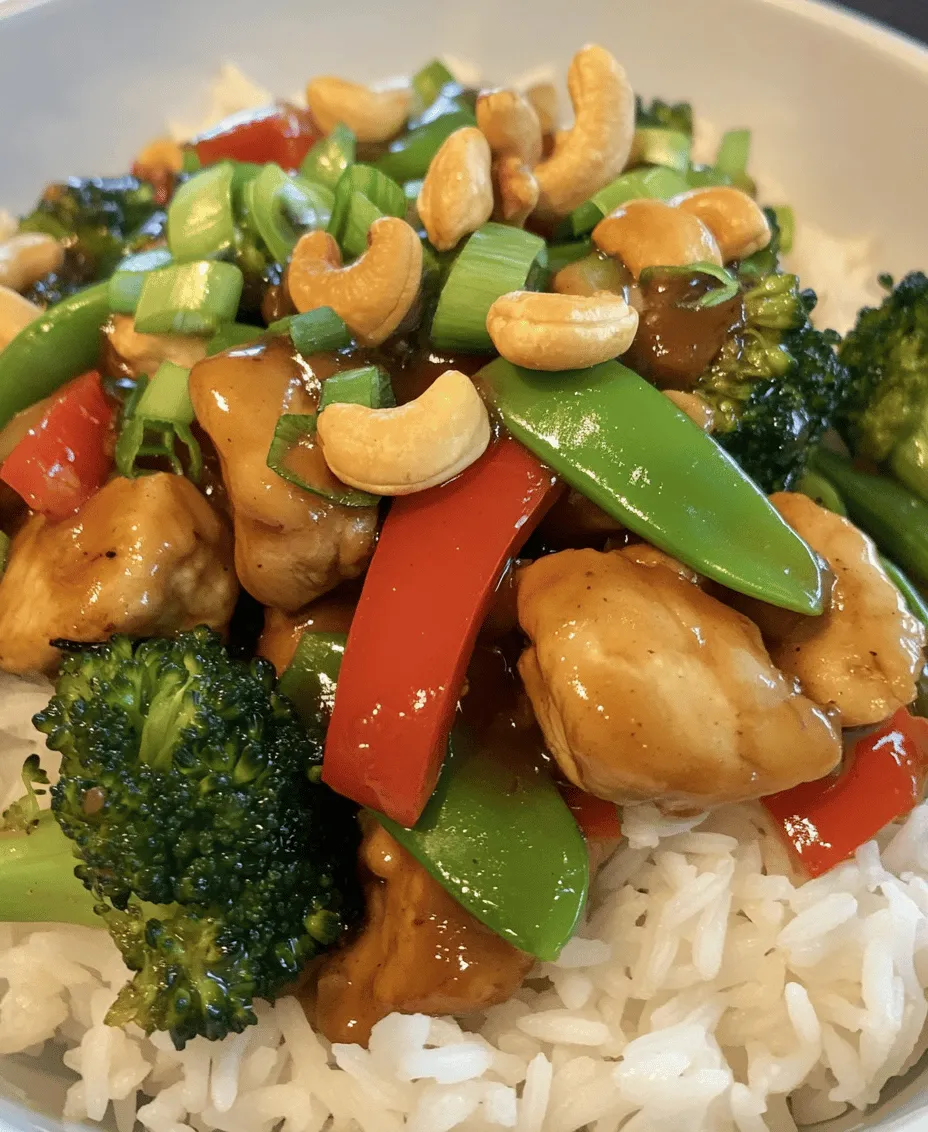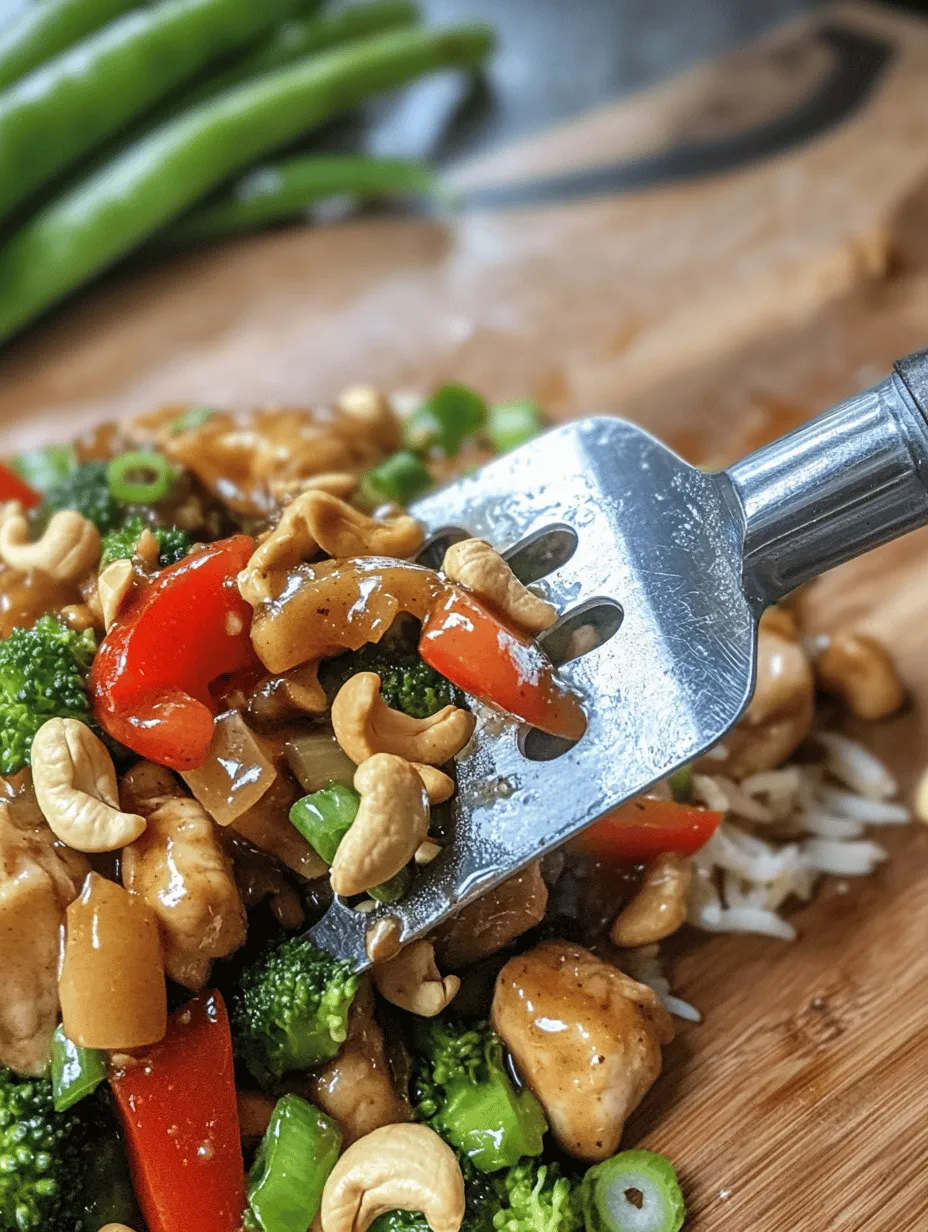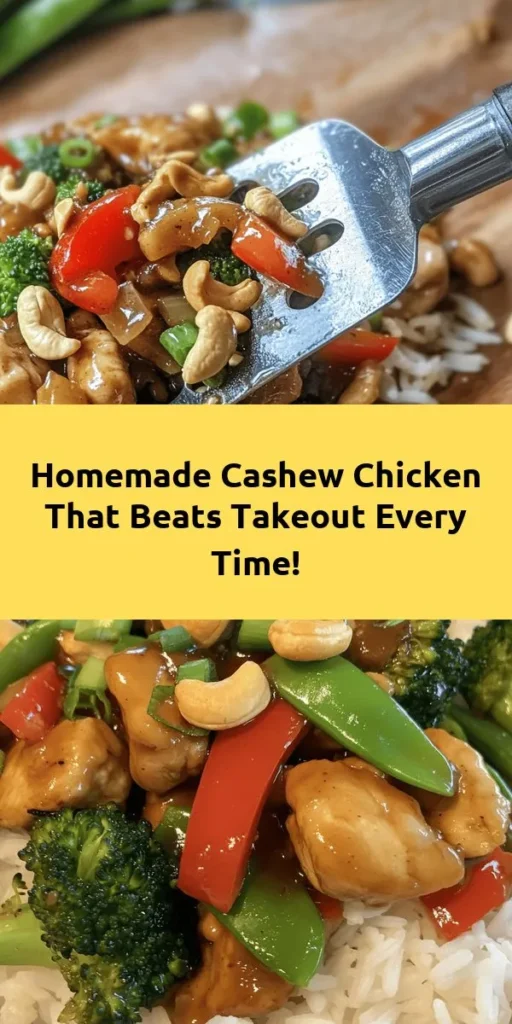Introduction
In recent years, the trend of homemade Asian cuisine has been surging, driven by a desire for healthier, fresher alternatives to takeout. As more people seek to recreate their favorite restaurant dishes in the comfort of their own kitchens, the concept of “better-than-takeout” meals has gained immense popularity. These dishes not only promise richer flavors but also allow for control over ingredients, making them a healthier choice for families and individuals alike.
Among the myriad of Asian dishes that have captured the hearts (and stomachs) of home cooks, cashew chicken stands out as a favorite. This dish is a perfect blend of tender chicken, crunchy cashews, and colorful vegetables, all enveloped in a savory sauce that tantalizes the taste buds. What makes this better-than-takeout cashew chicken recipe particularly appealing is its quick preparation time, making it an ideal option for busy weeknights when you want something satisfying without spending hours in the kitchen.
Imagine returning home from a long day, craving the comforting flavors of your favorite Chinese takeout, only to whip up a dish that not only rivals but surpasses it in taste and nutrition. This cashew chicken recipe is designed to do just that. Packed with protein, healthy fats, and vibrant vegetables, it’s a meal that your whole family will enjoy and one that you’ll feel good about serving.
Understanding the Ingredients
To create a truly outstanding cashew chicken, it’s crucial to understand the role of each ingredient in the dish. The combination of chicken, cashews, vegetables, and sauces not only contributes to the flavor but also ensures a well-rounded meal.
Chicken Breasts
At the heart of this dish is the chicken breast, a lean protein source that serves as the primary component. Chicken breasts are not only mild in flavor, allowing them to absorb the rich sauces beautifully, but they also cook quickly, making them a fantastic choice for fast weeknight meals. For the best results, it’s advisable to cut the chicken into bite-sized pieces, ensuring even cooking and easy eating.
Cashews
Cashews are where this dish earns its name and distinctive character. Beyond their satisfying crunch, these nuts bring a creamy richness that complements the savory elements of the dish. Nutritionally, cashews are a great source of healthy fats, protein, and essential minerals like magnesium and zinc. They elevate the texture of the dish while adding a delightful roasted flavor that ties everything together.
Vegetables
Incorporating a variety of vegetables into your cashew chicken not only enhances the dish’s visual appeal but also boosts its nutritional value. Common choices include bell peppers, broccoli, and carrots, which provide a colorful contrast and a mix of textures. Vibrant vegetables add crunch, sweetness, and a plethora of vitamins and minerals. The key is to balance the colors and textures to create a dish that’s as pleasing to the eye as it is to the palate.
Sauces
The flavor depth in cashew chicken comes from a combination of sauces, each contributing unique qualities to the overall taste profile.
– Soy Sauce: This staple of Asian cuisine adds umami and saltiness, enhancing the overall flavor of the dish.
– Oyster Sauce: Known for its rich, slightly sweet, and savory flavor, oyster sauce elevates the dish, providing a depth that is hard to replicate with other ingredients.
– Hoisin Sauce: This thick, sweet sauce adds a hint of sweetness and complexity, balancing the saltiness of soy sauce and the richness of oyster sauce.
– Sesame Oil: A few drops of toasted sesame oil at the end of cooking can impart a nutty aroma and flavor that brings the dish to life.
Understanding how these ingredients work together will set you up for success as you embark on this culinary adventure.
Marinating the Chicken
One of the secrets to achieving flavorful and tender cashew chicken lies in the marination of the chicken. Marinating helps infuse the meat with flavor and ensures that it stays juicy during cooking.
Importance of Marinating
Marinating serves two primary purposes: flavor enhancement and tenderness. By allowing the chicken to soak in a mixture of sauces and seasonings, you create a base layer of flavor that permeates the meat. Additionally, the acids in the marinade help to break down proteins, resulting in a more tender bite.
Step-by-Step Marination Process
1. Prepare the Marinade: In a bowl, combine soy sauce, a splash of oyster sauce, and a teaspoon of cornstarch. The cornstarch will not only help to tenderize the chicken but also create a protective coating that helps it retain moisture during cooking.
2. Add the Chicken: Place the bite-sized pieces of chicken breast into the marinade, ensuring that each piece is well-coated.
3. Marination Time: Cover the bowl and refrigerate for at least 30 minutes, or up to two hours if you have the time. This step is crucial for maximizing flavor and tenderness.
The Role of Cornstarch
Cornstarch plays a vital role in achieving that desired crispy texture that is often associated with takeout-style cashew chicken. When the chicken is coated in cornstarch, it forms a thin layer that crisps up beautifully during cooking, creating a contrast between the crunchy exterior and the tender meat inside. This technique is often referred to as “velveting” and is a popular method in Chinese cuisine to enhance the texture of chicken and other proteins.
Preparing the Flavorful Sauce
Now that the chicken is marinated, it’s time to prepare the sauce that will take your cashew chicken to the next level. The sauce is where the magic happens, transforming simple ingredients into a mouthwatering dish.
Sauce Ingredients and Flavor Profiles
The sauce for cashew chicken is a harmonious blend of flavors that balances sweetness, saltiness, and umami. Here’s a closer look at the primary components:
– Soy Sauce: As the base of the sauce, soy sauce provides essential saltiness and umami depth. It’s the backbone that ties all the other flavors together.
– Oyster Sauce: This rich, dark sauce adds a hint of sweetness and a more complex flavor profile than soy sauce alone. It’s a must-have for authentic-tasting Asian dishes.
– Hoisin Sauce: With its sweet and tangy profile, hoisin sauce adds a layer of richness and a subtle kick that enhances the overall taste.
– Cornstarch Slurry: Mixing cornstarch with a bit of water creates a slurry that can be added to the sauce during cooking. This will help thicken the sauce, giving it a luscious, glossy finish.
Combining the Sauces
To prepare the sauce, start by whisking together the soy sauce, oyster sauce, and hoisin sauce in a separate bowl. Adjust the ratios according to your personal taste; for instance, add more hoisin for sweetness or more soy sauce for saltiness.
Once you’ve achieved your desired flavor balance, set the sauce aside. It will be added to the stir-fried chicken and vegetables later in the cooking process, allowing all the flavors to meld beautifully.
Tips for Adjusting Sauce Ingredients
Everyone has different taste preferences, so don’t hesitate to experiment with the sauce ingredients. If you prefer a spicier kick, consider adding a dash of sriracha or some red pepper flakes. For a touch of acidity, a splash of rice vinegar or fresh lime juice can brighten the flavors. Remember, the goal is to create a sauce that complements the chicken and vegetables while catering to your palate.
Cooking Techniques
With the chicken marinated and the sauce prepared, you are ready to embark on the final steps of making your better-than-takeout cashew chicken. The cooking method is equally important in achieving that restaurant-quality finish.
Stir-Frying
Stir-frying is a quick cooking technique that retains the nutrients and flavors of the ingredients. It involves cooking food in a small amount of oil over high heat, allowing for rapid cooking and a delightful sear.
1. Preheat the Pan: Use a wok or a large skillet for the best results. Preheat the pan over medium-high heat until it’s hot. Adding the oil at this stage will help create a non-stick surface.
2. Add the Chicken: Carefully add the marinated chicken to the hot pan in a single layer. Avoid overcrowding the pan, as this can cause the chicken to steam rather than sear. Cook for about 4-5 minutes, stirring occasionally, until the chicken is golden brown and cooked through.
3. Incorporate the Vegetables: Once the chicken is cooked, it’s time to add the vegetables. Stir in your choice of colorful veggies, allowing them to cook for just a few minutes until they are tender-crisp. This will ensure that they maintain their vibrant color and nutritional value.
4. Add the Sauce: Pour the prepared sauce over the chicken and vegetables, stirring to coat everything evenly. If using a cornstarch slurry, add it at this stage to thicken the sauce, stirring continuously until it reaches the desired consistency.
5. Final Touches: Once everything is well-coated and heated through, it’s time to finish the dish with a sprinkle of roasted cashews and, if desired, a drizzle of sesame oil for an extra touch of flavor.
By following these steps, you’ll create a dish that not only rivals takeout but elevates it, offering a satisfying meal that’s quick, healthy, and bursting with flavor.

Importance of Using High Heat for Stir-Frying
When it comes to cooking the perfect cashew chicken, using high heat is paramount. Stir-frying requires rapid cooking to ensure that the ingredients are seared properly, locking in their flavors and juices. High heat allows for the Maillard reaction to take place, which enhances the flavors of your chicken and vegetables, creating a deliciously caramelized outer coating.
The importance of high heat cannot be overstated. When stir-frying, the goal is to cook the food quickly while maintaining its texture and moisture. If the heat is too low, the chicken can become tough and rubbery, and the vegetables can turn soggy instead of retaining their vibrant crunch. Therefore, a well-preheated wok or skillet is essential for achieving that restaurant-quality texture and flavor in your cashew chicken.
Difference Between Sautéing and Stir-Frying
While sautéing and stir-frying may appear similar at first glance, they are distinct cooking techniques with different outcomes. Sautéing typically involves cooking food over medium heat with a small amount of fat—often in a skillet—where the food is turned occasionally. This method is ideal for cooking larger pieces of meat or vegetables and allows them to cook evenly.
On the other hand, stir-frying is a quicker process performed over high heat, where the ingredients are continuously stirred or tossed in the pan. This technique is best suited for smaller, uniformly cut ingredients that require fast cooking. The quick motion and high temperature of stir-frying produce a delightful crispness in vegetables while keeping proteins tender and juicy. For your cashew chicken, mastering the art of stir-frying will ensure that each bite is bursting with flavor.
Step-by-Step Instructions on Cooking Chicken
To achieve optimal texture and flavor for your cashew chicken, proper preparation and cooking of the chicken are essential. Follow these steps for the best results:
1. Marinate the Chicken: Begin by cutting boneless, skinless chicken breasts into bite-sized cubes, about 1 inch. In a bowl, combine the chicken with soy sauce, rice vinegar, a dash of sesame oil, and cornstarch. Let it marinate for at least 15-30 minutes. This process not only infuses flavor but also helps to tenderize the meat.
2. Preheat Your Pan: Heat a wok or large skillet over high heat until it is smoking hot. Add a tablespoon of vegetable oil, swirling it around to coat the bottom.
3. Cook the Chicken: Add the marinated chicken to the pan in a single layer, ensuring not to overcrowd the pan. Allow it to sear without stirring for about 2-3 minutes until the bottom is golden brown. Then, quickly stir-fry the chicken for an additional 2-3 minutes until it is cooked through and no longer pink in the center. Remove the chicken from the pan and set it aside to keep it warm.
Stir-Frying Vegetables
Vegetable freshness plays a crucial role in the overall success of your cashew chicken. Fresh, vibrant vegetables not only enhance the dish’s appearance but also contribute to its flavor profile. Here are some key tips for stir-frying vegetables effectively:
– Choose Colorful Vegetables: Opt for a mix of bell peppers, broccoli, and snap peas for a visually appealing dish. The bright colors not only make the dish more enticing but also signify freshness and nutrients.
– Timing is Everything: The order in which you add your vegetables affects their tenderness and crunch. Start with firmer vegetables like carrots and bell peppers, cooking them for about 2-3 minutes. Next, add quick-cooking vegetables such as broccoli and snap peas, and stir-fry for an additional 1-2 minutes until they are bright green and tender-crisp.
– Maximize Flavor with Aromatics: Enhance the flavor profile by adding minced garlic and ginger to the oil before introducing the vegetables. This step allows the aromatics to infuse the oil, creating a fragrant base for your dish. Stir-fry the garlic and ginger for about 30 seconds until fragrant, then quickly add your vegetables.
Combining Ingredients
Once your chicken and vegetables are cooked to perfection, it’s time to bring everything together for a harmonious dish. Follow these steps to combine your ingredients effectively:
1. Return Chicken to the Pan: Add the cooked chicken back into the pan with the vegetables, ensuring everything is well-mixed.
2. Incorporate the Sauce: Pour your pre-prepared sauce over the chicken and vegetables. Stir well to ensure that every piece is coated evenly. The sauce will start to thicken as it heats, creating a glossy glaze that clings to the chicken and vegetables.
3. Mix Thoroughly: Continue to stir-fry for another 1-2 minutes until the sauce is heated through and has thickened to a desirable consistency. This mixing process allows the flavors to meld together beautifully, ensuring every bite is packed with deliciousness.
Finishing Touches
To elevate your cashew chicken, the final touches are crucial:
– Add Cashews: Stir in the roasted cashews during the last minute of cooking. This not only adds a delightful crunch but also enhances the flavor profile of the dish. The heat will warm the cashews, releasing their nutty aroma and making them even more addictive.
– Garnish with Green Onions: Finally, sprinkle freshly chopped green onions over the top before serving. These not only add a pop of color but also contribute a mild onion flavor and freshness that perfectly balances the richness of the dish.
Serving Suggestions
Cashew chicken is versatile and can be served in various ways to suit your preferences:
– Perfect Pairings: Serve your cashew chicken over a bed of fluffy jasmine rice, which complements the flavors beautifully. Alternatively, consider pairing it with fried rice or quinoa for a nutritious twist.
– Presentation Tips: To make your dish visually appealing, consider using a large platter or individual bowls. Garnish with additional cashews and green onions for a touch of elegance. A sprinkle of sesame seeds can also add a beautiful finishing touch.
– Nutritional Benefits: This homemade cashew chicken is not only delicious but also offers nutritional benefits. The chicken provides lean protein, while the vegetables add essential vitamins and fiber. Cashews contribute healthy fats and minerals, making this dish a balanced option for a satisfying meal.
Conclusion
Making cashew chicken at home is a rewarding experience that far outweighs ordering takeout. By mastering the techniques of high-heat stir-frying, you can achieve a dish that is bursting with flavor and texture. The ability to control the ingredients means you can create a healthier version that caters to your dietary preferences.
Don’t hesitate to explore variations of this recipe by adding different vegetables such as bell peppers or snow peas, or even swapping the chicken for tofu or shrimp for a delightful twist. Cooking is not just about following a recipe; it’s about enjoying the process and creating meals that bring joy to your table.
So, gather your ingredients, ignite your passion for cooking, and enjoy the delightful experience of making your own cashew chicken. You’ll savor every bite, knowing it’s made with love and care in the comfort of your home.



